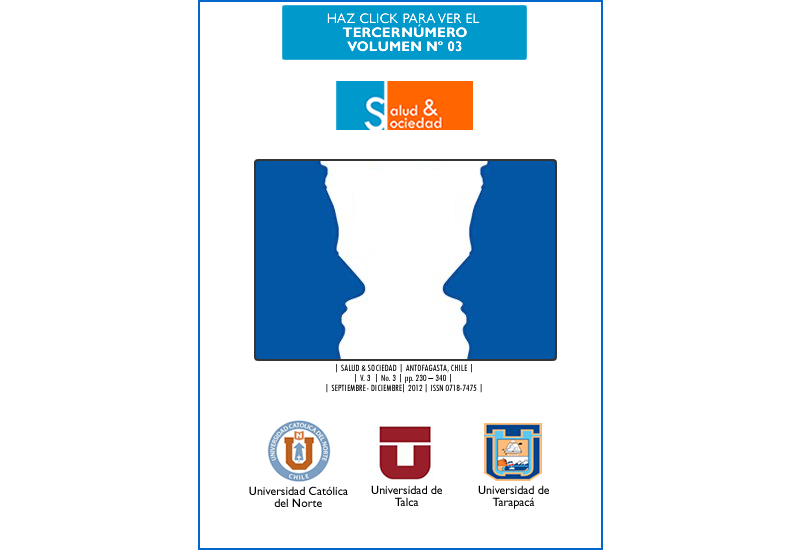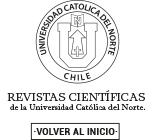Validación colombiana de la escala pediátrica de somnolencia y cuestionario Cleveland de somnolencia para la adolescencia.
DOI:
https://doi.org/10.22199/S07187475.2012.0003.00003Palabras clave:
Somnolencia excesiva diurna en niños y adolescentes, psicometría, validez interna, validez externa, caracterización psicométrica, Excessive daytime sleepiness in children and adolescents psychometrics, internal validity, external validity,Resumen
Objetivos. El propósito de este estudio es establecer las características psicométricas en la población colombiana del municipio de Sabaneta del Cuestionario Pediátrico de Somnolencia Excesiva Diurna y del Cuestionario Cleveland de Somnolencia Excesiva para Adolescentes. Diseño. Estudio descriptivo de tipo transversal, en una población de niños escolarizados, no se incluye población patolológica ni evaluación clínica. Medidas. Se utilizaron el Cuestionario Cleveland de Somnolencia para Adolescentes Versión Colombiana, el cuestionario pediátrico de sueño versión colombiana, el Inventario de Depresión para Niños, el EDAH y las sub-escalas de somnolencia y trastornos respiratorios del sueño del PSQ versión Colombiana. Se realizan procedimientos de coeficiente de fiabilidad, análisis factorial, correlación inter ítem e inter-escala, regresión lineal y prueba test-retest, lo mismo que índice de concordancia inter-evaluadores. Participantes. La población escogida fueron 324 niños y adolescentes escolarizados en colegios públicos y privados del municipio de Sabaneta Antioquia entre los 6 a los 17 años. Resultados. La escala pediátrica de somnolencia, se obtiene un índice Kappa de 0,927, En el puntaje global del cuestionario Cleveland de somnolencia para adolescentes se obtiene un índice de Kappa de 0,867. En la EPS-VC alfa de Cronbach de 0,734, las correlaciones de cada ítem con el puntaje global de la escala fueron también positivas y significativas (P<0,01). La varianza total explicada de la prueba apunta a describe un 59,9%. En el CCSA se obtiene un alfa de Cronbach de 0,759, presentan correlaciones significativas (p<0,01), La varianza total explicada para esta prueba es del 56,9%. Conclusiones. Ambos instrumentos en general presentan características apropiadas de validez de contenido, de criterio y de constructo, que hacen que su uso en la población colombiana sea razonable.
Objectives. The purpose of this study is to establish the psychometric characteristics of the population of the municipality of Sabaneta, Colombia, using the Pediatric Sleepiness Scale and the Cleveland Sleepiness Questionnaire for Adolescents. Design. Cross-sectional descriptive study in a population of school children was used. Neither pathological population nor clinical evaluation is included in this study. Instruments. The instruments used were the Cleveland Adolescent leepiness Questionnaire, Colombian version, the Children's Depression Inventory, the ADHS, and sleepiness and the sleep-disordered breathing sub-scales of the Colombian version of the PSQ. Procedures performed were reliability coefficient, factor analysis, inter-item and inter-scale correlation, linear regression and test-retest, which indicates inter-concordance index evaluators. Participants. The population surveyed consisted of 324 children and adolescents enrolled in public and private schools in the municipality of Sabaneta Antioquia, Columbia. Results. The Pediatric Sleepiness scale yields a Kappa index of 0.927. The overall score of the Cleveland Adolescent Sleepiness Questionnaire yields a Kappa index of 0.867. In the EPS-VC Cronbach's alpha of 0.734, the correlations of each item with the total score of the scale are both positive and significant (P<0.01). The total variance explained by the described test points to 59.9%. The CCSA obtained a Cronbach's alpha of 0.759, showing significant correlations (p <0.01). Total explained variance for this test is 56.9%. Conclusions. Both instruments have characteristics generally appropriate content validity, criterion and construct, making their use in the Colombian population appropriate.
Descargas
Referencias
Blunden S., Hoban T. y Chervin R. (2006) Sleepiness in Children, Sleep Medicine Clinics. 1, 105–118.
Boergers J., Hart C., Owens J., Streisand R. y Spirito A (2007) Child Sleep Disorders: Associations With Parental Sleep Duration and Daytime Sleepiness. Journal of Family Psychology. 21, 88-94.
Bruni O., Ottaviano S., Guidetti M., y cols. (1996). The sleep disturbance scale for children: construction and validation of an instrument to evaluate sleep disturbance in childhood and adolescence. Journal Sleep Research 5,251–61.
Bruni O; Ferri R; Vittori E; Novelli L; Vignati M; Porfirio MC; Aricò D; Bernabei P; Curatolo P. (2007) Sleep architecture and NREM alterations in children and adolescents with asperger syndrome. Sleep. 30,1577-1585.
Camargo JC y Marín HA (2009) Validación Colombina del Cuestionario Oediátrico de Sueño. Trabajo de grado no publicado, Facultad de psicología, Universidad Cooperativa de Colombia, seccional Medellín.
Calhoun SL, Fernandez-Mendoza J, Vgontzas AN, Mayes SD, Tsaoussoglou M, Rodriguez-Muñoz A y Bixler EO. Learning, attention/hyperactivity, and conduct problems as sequelae of excessive daytime sleepiness in a general population study of young children. Sleep. 2012 May 1;35(5):627-32.
Campbell I., Higgins L., Trinidad J., Richardson P. y Feinberg I. (2007) The increase in longitudinally measured sleepiness across adolescence is related to the maturational decline in low-frequency EEG power. Sleep. 30,1677-1687.
Carrot B, y Lecendreux M. (2011) Evaluation of excessive daytime sleepiness in child and adolescent psychopathology. Arch Pediatr. 18(8):891-901.
Carskadon M., Harvey K. y Dement W. (1981) Acute restriction of nocturnal sleep in children. Perceptual and Motor Skills 53:103–114.
Carskadon M.A. (1982) The second decade. In: Guilleminault C, editor. Sleeping and waking: indications and techniques. Menlo Park (CA): Addison Wesley; 1982. p. 99–125.
Chan E., Ng D., Chan C., Kwok K., Chow P., Cheung J., y Suk-yu Leung S. (2009) Modified Epworth Sleepiness Scale in Chinese children with obstructive sleep apnea: a retrospective study. Sleep Breath 13, 59–63
Chervin R.D., Archbold K.H., Dillon J.E., y cols. (2000). Pediatric Sleep Questionnaire (PSQ): validity and reliability of scales for sleep disordered breathing, snoring, sleepiness and behavioural problems. Sleep Medicine. 1,21–32.
Drake C, Nickel C, Burduvali E, et al. The pediatric daytime sleepiness scale (PDSS): sleep habits and school outcomes in middle-school children. Sleep 2003;26:455–8.
Dewald J. Meijer A., Oort F., Kerkhof G. y Bögels S. (2010) The influence of sleep quality, sleep duration and sleepiness on school performance in children and adolescents: A meta-analytic review Sleep Medicine Reviews. 14,179-189.
Farré A., y Narbona García J (2003) EDAH: escalas para la evaluación del trastorno por déficit de atención con hiperactividad, Madrid, TEA Volumen 264 de Publicaciones de Psicología Aplicada 56p.
Fallone G., Seifer R., Acebo C., et al. (2000) Prolonged sleep restriction in 11 and 12 year old children: effects on behaviour, sleepiness and mood. Sleep 23, A28.
Fallone G., Acebo C, Arendt T., y cols. (2001) Effects of acute sleep restriction on behaviour, sustained attention and response inhibition in children. Perceptual and Motor Skills 93, 213–229.
Fleiss JL. (1986) The design and analysis of clinical experiments. New York: John Wiley and Sons.
Gaina A, Sekine M, Hamanishi S, Chen X, Wang H, Yamagami T And Kagamimori S (2007) Daytime Sleepiness and Associated Factors in Japanese School Children. J Pediatr 151:518-522
Gau S. y Soong W. (2003). The transition of sleep-wake patterns in early adolescence. Sleep. 26,449-454.
Gómez, Y., Alvis A. y Sepúlveda M. (2003). Características psicométricas del instrumento Childrens Depresión Inventory (CDI), para detectar sintomatología depresiva en niños de 8 a 12 años de edad, en la ciudad de Medellín. En: Psicog: Investigaciones de psicología clínica cognitivo comportamental en la ciudad de Medellín. Medellín: Universidad de Antioquia.
Gozal D., Wang M., Pope D., y cols. (2001) Objective sleepiness measures in pediatric obstructive sleep apnea. Pediatrics 108, 693–697.
Guilleminault C, Pelayo R. (1998) Narcolepsy in prepubertal children. Annals of Neurology 43,135–42.
Hoddes E., Dement W. y Zarcone V. (1972) The development and use of the Stanford Sleepiness Scale (SSS). Psychophysiology 9,150–156.
Huang Y. y Guilleminault C. (2009) Narcolepsy: action of two gammaaminobutyric acid type B agonists, baclofen and sodium oxybate. Pediatric Neurology. 41, 9-16.
Jenni O., Achermann P. y Carskadon M. (2005). Homeostatic sleep regulation in adolescents. Sleep 28, 1446-1454.
Johns M.W. (1991). "A new method for measuring daytime sleepiness: the Epworth sleepiness scale". Sleep 14, 540–545.
Kotagol S, y Gouldin P. (1996) The laboratory assessment of daytime sleepiness in childhood. Journal of Clinical Neurophysiology 13,208–218.
Kovacs, M. (1985). The childrens depression inventory. Psychopharmacology Bulletin. 21, 995-998.
Maganti R., Hausman N., Monica Koehn M., Sandok E., Glurich I. y Mukesh B. (2006) Excessive daytime sleepiness and sleep complaints among children with epilepsy. Epilepsy y Behavior. 9, 216-217.
Maldonado C., Bentley A. y Mitchell D. (2004). A pictorial sleepiness scale based on cartoon faces. Sleep. 27, 541-548.
Marín, H.A. y Vinaccia, S. (2004). Calidad de vida y somnolencia excesiva diurna. en: Oblitas, L (Eds): Manual de psicología de la salud y hospitalaria. Libro electrónico www.psicologiacientífica.com.
Marín H.A. (2010) Cuestionarios de somnolencia excesiva diurna: las medidas subjetivas de la somnolencia excesiva diurna. En: Marín HA (eds), Privación de sueño: Fundamentos clínicos y básicos. Divergráficas, Medellín 378p.
Melendres M.C., Lutz J.M., Rubin E.D., y cols. (2004) Daytime sleepiness and hyperactivity in children with suspected sleep disordered breathing. Pediatrics 14,768–775.
Mindell J.A. y Durand V.M. (1993) Treatment of childhood sleep disorders: generalization across disorders and effects on family members. Journal of Pediatric Psychology. 18,731–750.
Mindell J. y Meltzer L. (2008) Behavioural Sleep Disorders in Children and Adolescents. Annals Academy of Medicine. 37, 722-728.
Nixon G., Wawruszak M., Verginis N. y Davey M. (2006) P363 The pediatric daytime sleepiness scale in elementary school children. Sleep Medicine, 7 (Supple 2), S71-S72.
Ohayon M. (2008) From wakefulness to excessive sleepiness: What we know and still need to know. Sleep Medicine Reviews. 12, 129-141.
Onyper SV, Thacher PV, Gilbert JW, Gradess SG. Class start times, sleep, and academic performance in college: a path analysis. Chronobiol Int. 2012 Apr;29(3):318-35.
Owens J., Spirito A. y McGuinn M. (2000) The children’s sleep habits questionnaire (CSHQ): psychometric properties of a survey instrument for school-aged children. Sleep 23,1043–1051.
Perez-Chada D., Perez-Lloret S., Videla A., Cardinali D., Bergna M., FernándezAcquier M., Larrateguy L., Zabert GE. Y Drake C. (2007) Sleep disordered breathing and daytime sleepiness are associated with poor academic performance in teenagers. A study using the pediatric daytime sleepiness scale (PDSS). Sleep. 30,1698-1703.
Randazzo AC, Schweitzer PK, Walsh JK. (1998) Cognitive function following acute sleep restriction in children ages 10–14. Sleep 21,861–868.
Roure N., Gomez S., Mediano O., Duran J., Peña M., Capote F., Teran J., Masa J., Alonso M., Corral J., SánchezArmengod A., Martinez C., Barceló A., Gozal D., Marín J. y Barbé F (2008) Daytime sleepiness and polysomnography in obstructive sleep apnea patients. Sleep Medicine. 9, 727-731.
Saarenpaa O., Laippala P. y Koivikko M. (2000) Subjective sleepiness in children. Family Practice 17, 129–133.
Schneider A. y Randler C. (2009) Daytime sleepiness during transition into daylight saving time in adolescents: Are owls higher at risk? Sleep Medicine. 10, 1047-1050.
Spencer T., Greenbaum M., Ginsberg L. y Murphy W. (2009) Safety and Effectiveness of Coadministration of Guanfacine Extended Release and Psychostimulants in Children and Adolescents with Attention-DeficitHyperactivity Disorder. Journal of Child and Adolescent Psychopharmacology.19, 501-510.
Spilsbury J., Drotar D. Rosen C. y cols. (2007). The Cleveland adolescent sleepiness questionnaire: a new measure to assess excessive daytime sleepiness in adolescents. Journal of Clinical Sleep Medice 3,603-612.
Stuck B., Czajkowski J., Hagner A, Klimek L., Verse T., Hörmann K., y Maurer J. (2004) Changes in daytime sleepiness, quality of life, and objective sleep patterns in seasonal allergic rhinitis: A controlled clinical trial. Journal of Allergy and Clinical Immunology. 113, 663-668.
Wooldridge N., Westbrook H., Makris C. y Avis K. (2009). Relationship between BMI, Nutrition Knowledge, and Daytime Sleepiness in a Pediatric Population Suffering from Obstructive Sleep Apnea Syndrome. Journal of the American Dietetic Association, 109, (Suppl1), A38.
Yang C.M., Huang Y.S. y Song Y.C. (2010) Clinical utility of the Chinese version of the Pediatric Daytime Sleepiness Scale in children with obstructive sleep apnea syndrome and narcolepsy. Psychiatry and Clinical Neuroscience. 64, 134 – 140.
Descargas
Publicado
Número
Sección
Licencia
Los autores continúan como propietarios de sus trabajos, y pueden volver a publicar sus artículos en otro medio sin tener que solicitar autorización, siempre y cuando indiquen que el trabajo fue publicado originariamente en Revista Salud & Sociedad (ISSNe:0718-7475).



_(1).png)





